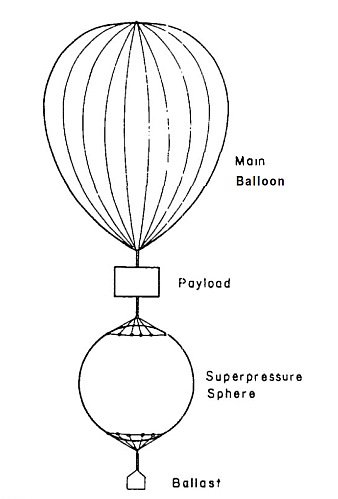Purpose of the flight and payload description
The Sky Anchor System was a two balloon system developed and tested by the National Scientific Balloon Facility (NSBF), during the 70's and 80's decade as part of a long lasting effort of the agency to develope a long duration balloon system. The concept -originally tested in a small scale in 1963- was boosted by the needs of the scientific ballooning community which could benefit in many areas of interest from longer exposure times at altitude. The final goal of the developmental effort was to built a vehicle capable of transport a 500 lb scientific payload at 130,000 ft for a minimum of 100 days duration.
The Sky Anchor system used a two balloon system on which a conventional zero pressure balloon (open) carried below a super pressure balloon (closed) which acted as ballast and anchor. In the image at left is a basic scheme of the system (a more detailed description can be seen clicking over the drawing).
The theoretical operation of the system was as follows. Once the system was airborne, on the way to the main balloon's operational altitude, the super pressure became filled and pressurized. As the "super pressure" continued to be carried upward it losed more and more lift. When sunset occured the entire system descended to a new equilibrium altitude where the increase in lift on the super pressure balloon just equaled the sunset effect on the main balloon. Although its volume was decreased, no gas was lost from the main balloon. At sunrise, the main balloon expanded and the system once again rose. In so doing the super pressure balloon losed the lift that it gained at sunset and the system stabilized at the same altitude as the preceding day. Since there was no change in suspended weight on the main balloon, it should not overshoot and again there will be no loss of gas. As in the pure super pressure system, assuming there were no leaks, the flight duration was limited only by creep, gas diffusion and ultraviolet degradation of the balloon fabric.
Throughout the development of the program, the actual flight experience turned out to be much more complex than planned, so after mixed results on 14 flights over six years, the program was abandoned in 1982. However, the experience gained would pave the way for other groups to develop more successful designs in the future. This would allow the original goal behind Sky Anchor to be achieved in the early decades of the 21st century.
Details of the balloon flight
Balloon launched on: 1/19/1977
Launch site: Page Airport, Arizona, US
Balloon launched by: National Scientific Balloon Facility (NSBF)
Balloon manufacturer/size/composition: Zero Pressure Balloon Winzen - 117.091 m3 (12.70 microns)
Flight identification number: 127NT
End of flight (L for landing time, W for last contact, otherwise termination time): 1/19/1977
Balloon flight duration (F: time at float only, otherwise total flight time in d:days / h:hours or m:minutes - ): F 7 h
Landing site: In Colorado, US
Payload weight: 612 kgs
This was the first test flight of the system. Sky Anchor I mission was launched from Page, Arizona on January 19, 1977. The system consisted of a 4.130.000 cubic feet zero pressure balloon, a 540-lb payload, and a 1.250.000 cubic feet super pressure. The launch and initial ascent went as expected except for a slightly higher ascent rate than desired. The reefing system had started to deploy properly and at approximately 33,000 feet visual was lost due to clouds. At approximately 52,000 feet a sudden drop in altitude was registered. The system then continued to ascend to a float altitude of 119,000 feet. After obtaining several visual sightings that the super pressure had failed, the flight was terminated in Colorado. Down cameras revealed that the reefing sleeve slit all the way down the balloon thus allowing the sphere to open up into a gigantic sail. At this altitude a shear was encountered which, due to the sailing balloon, probably caused severe loading and failure. Total flight time at float was neat 7 hours.
After the test flight of Sky Anchor I, theoretical work continued on the system. Some of the basic changes introduced for the next mission were to shorten the ballast sphere-payload tether line so that there was a smaller shear velocity gradient between the ballast sphere and the main zero pressure balloon; utilize a bottom load attachment harness with some pressurization ballast to help ''string out" the sphere to prevent sailing (rather than a reefing system); utilize a valve in the top of the main zero pressure balloon to valve off some free lift so that a slow ascent rate can be maintained; and use a lower percentage of free lift in the main balloon.
External references
- Advances in long duration, high altitude flights Advances in Space Research, Volume 1, Issue 11, 1981, Pag. 193
- Development of the Sky Anchor Balloon System AFGL-TR-79-0053, Special Reports No. 217, 1978
- National Scientific Balloon Facility Annual Report, FY 1977 National Center for Atmospheric Research, 1978
10221If you consider this website interesting or useful, you can help me to keep it up and running with a small donation to cover the operational costs. Just the equivalent of the price of a cup of coffee helps a lot.


